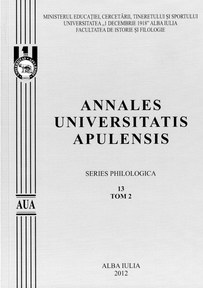Ficţiunea lui Radu Petrescu în grilă naratologică. Aspecte ale textului postmodern
Radu Petrescu’s fiction in narratological scheme. Aspects of the postmodern text
Author(s): Oana CodarceaSubject(s): Literary Texts
Published by: Universitatea »1 Decembrie 1918« Alba Iulia
Keywords: polyphonic narrative; metaliterature; temporal discontinuity; narratological approach; textual microstructure
Summary/Abstract: Starting from the idea that the writers from Şcoala de la Târgovişte group are founders of Romanian postmodernism and Radu Petrescu is a member of this group, we will submit his fiction prose to a narratological "postmodern" schedule in order to perceive the constituent elements of the narrative discourse and the defining features of the one who constantly stated that his main concern is composition. The phenomenon of narrative polyphony is reflected in the fictions included in Addenda to A treia dimensiune by replacing the narrative courts, the narrator, the character and the reader constantly switching places. In Sinuciderea din Grădina Botanică this process is more organized because the performance of the three types on narrators follows a regulation. The homodiegetic narrator’s discourse succeeds the autodiegetic’s and the extradiegetic’s narration comes after the ones mentioned before. The postmodern fiction drops out the logical succession of events, counting now on emotions and feelings produced by the occurrence and not by the story itself, which leads to inability to "tell" the prose. Past, present and future actions are brought together in the narrative, a phenomenon that leads to hinder reading. Another feature of postmodern fiction is to create continuity between fiction, not by narrative development, but by using the same characters or sequences. The phenomenon of circular sequences released as concept by Cristina Hăulică is to be found in the fictional prose of Radu Petrescu as an identical form of repetition or with insignificant changes, at least apparently. Temporal discontinuity is a trademark of postmodernism perfectly visible in the writings of Radu Petrescu, for the priority seems to be creating the sensation of multiple beginnings in unity "Each chapter is a new beginning. The novel must make this very valuable and necessary unit as fortuitous as life itself" (Radu Petrescu). We will analyze the starting elements and those from the epilogue in order to distinguish the similarities and the differences with ragard to classical prose. The recommendation of Gerard Genette to operate analysis within microstructures of the prose will be taken into consideration because otherwise we risk to neglect the diversity and the coexistence of the tools that are used.In this material, the character, an element of the narrative text, will not be subjected to a thorough analysis as it will be the subject of an independent research. The references to this category will be made in order to create links with other structures forming the core of the narrative.
Journal: Annales Universitatis Apulensis. Series Philologica
- Issue Year: 13/2012
- Issue No: 4
- Page Range: 39-58
- Page Count: 18
- Language: Romanian

